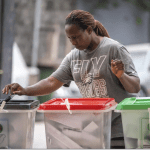South Africa’s current account deficit expanded to 1.1% of GDP in the second quarter of 2025, up from a revised 0.6% in the first quarter, the South African Reserve Bank (SARB) reported on September 11, 2025. In rand terms, the deficit grew to 82.8 billion rand ($4.72 billion) from 47.8 billion rand in Q1.
Trade Surplus Shrinks
The SARB noted a narrowing trade surplus, dropping to 177.1 billion rand in April–June from 211 billion rand in January–March.
Exports fell by 23.3 billion rand due to lower volumes, while imports rose by 8.2 billion rand, driven by higher prices. This imbalance contributed significantly to the wider deficit.
Factors Behind the Shift
The decline in export values reflects weaker global demand for South African commodities like platinum and coal. Domestic challenges, such as port and rail inefficiencies, further hampered export competitiveness.
Higher dividend and interest payments to foreign investors also strained the current account, pushing the services, income, and current transfer deficit to 259.9 billion rand from 258.9 billion rand.
Economic Context
South Africa’s economy grew by 0.8% in Q2, driven by manufacturing, mining, and consumer spending, but the wider deficit signals ongoing challenges.
The country has faced seven consecutive quarters of current account shortfalls, worsened by US tariffs, including a 30% levy on South African exports introduced in August 2025. These trade frictions add pressure to an already strained economy.
Looking Ahead
The SARB highlighted potential relief from improved logistics and infrastructure reforms, which could ease export bottlenecks.
However, economists warn that sustained deficits may increase reliance on foreign capital, risking rand volatility. Policymakers aim to stabilize trade conditions to narrow the gap in future quarters.
Why It Matters
The growing current account deficit raises concerns about South Africa’s economic stability. It underscores the need for structural reforms to boost exports and reduce reliance on foreign funding, especially amid global trade tensions and domestic constraints.























